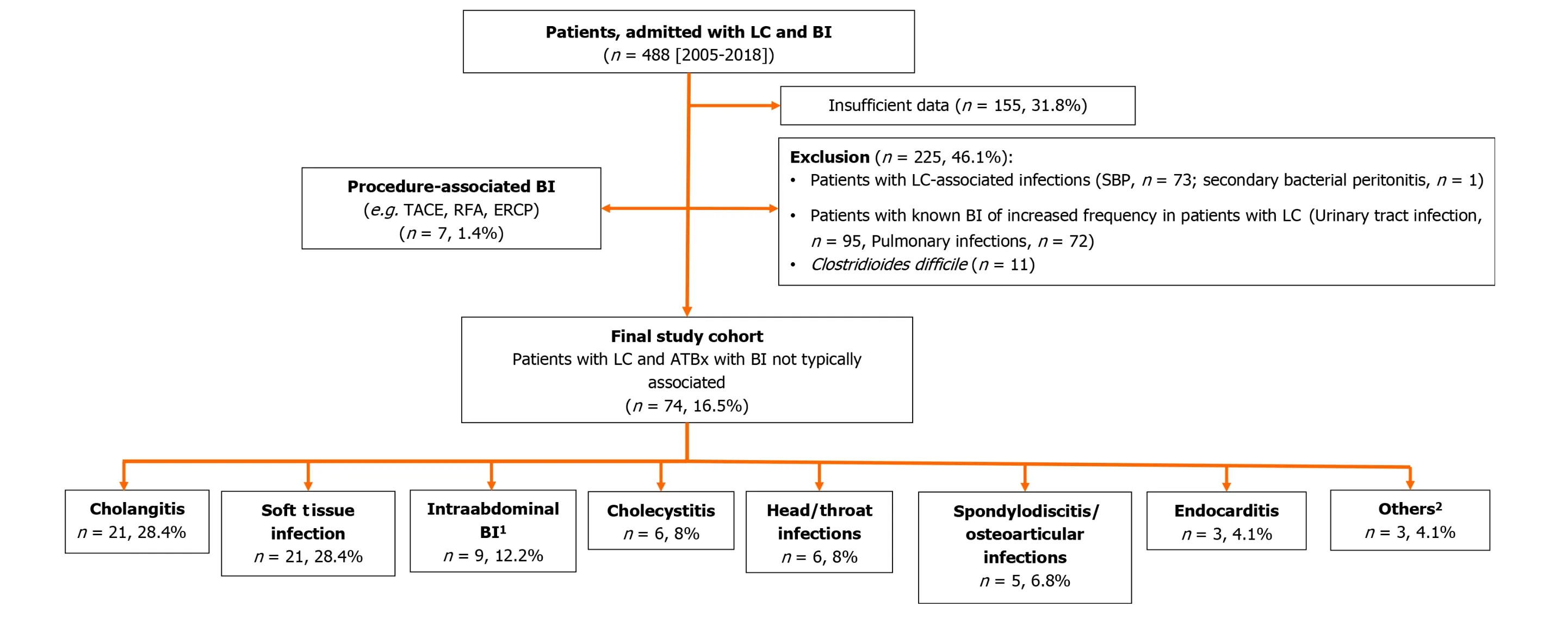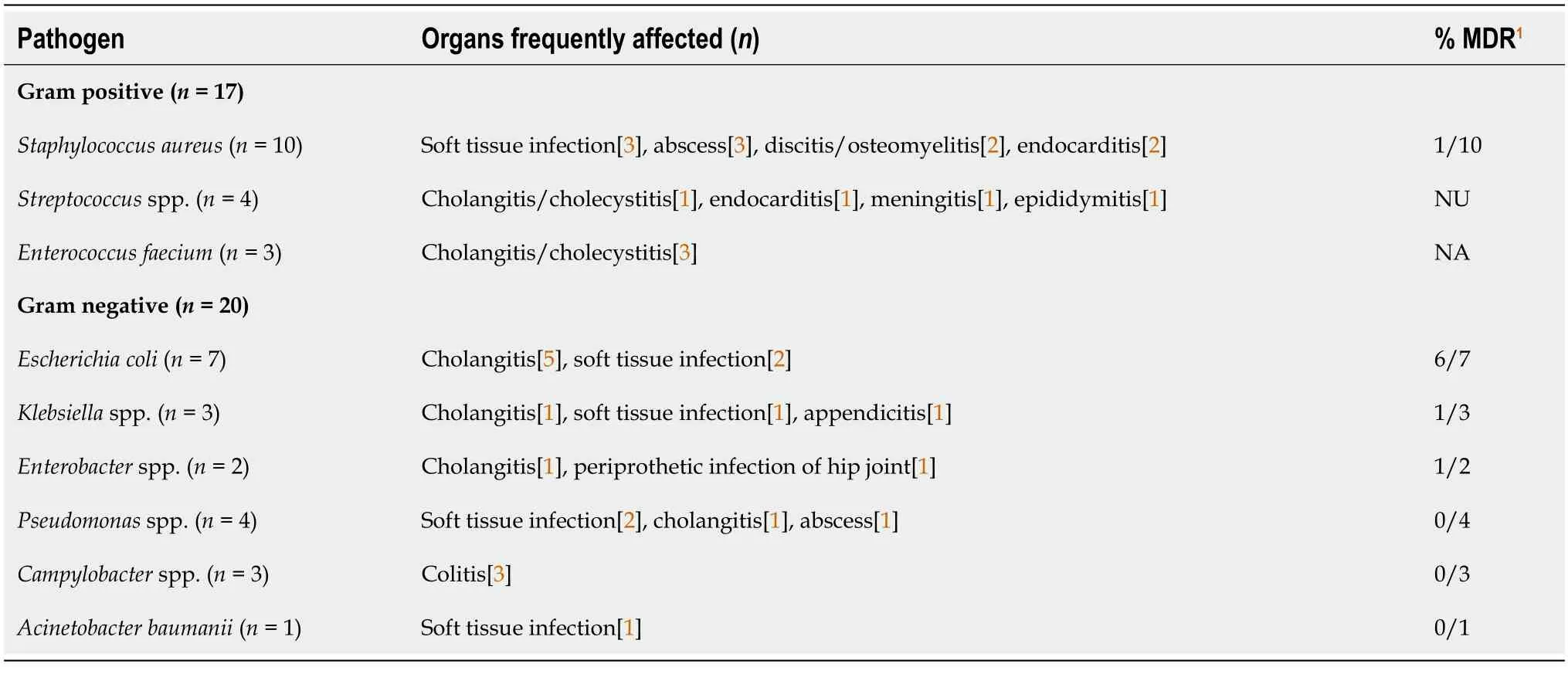Retrospective study of the incidence, risk factors, treatment outcomes of bacterial infections at uncommon sites in cirrhotic patients
Sophie Schneitler, Christina Schneider, Markus Casper, Frank Lammert, Marcin Krawczyk, Sören L Becker,Matthias Christian Reichert
Abstract BACKGROUND Bacterial infections (BI) negatively affect the natural course of cirrhosis. The most frequent BI are urinary tract infections (UTI), pneumonia, and spontaneousbacterial peritonitis (SBP).AIM To assess the relevance of bacterial infections beyond the commonly recognized types in patients with cirrhosis and to investigate their relationship with other clinical variables.METHODS We retrospectively analyzed patients with cirrhosis and BI treated between 2015 and 2018 at our tertiary care center. BIs were classified as typical and atypical, and clinical as well as laboratory parameters were compared between the two groups.RESULTS In a cohort of 488 patients with cirrhosis, we identified 225 typical BI (95 UTI, 73 SBP, 72 pulmonary infections) and 74 atypical BIs, predominantly cholangitis and soft tissue infections (21 each), followed by intra-abdominal BIs (n = 9), cholecystitis (n = 6), head/throat BIs (n = 6), osteoarticular BIs (n = 5), and endocarditis (n = 3). We did not observe differences concerning age, sex, or etiology of cirrhosis in patients with typical vs atypical BI. Atypical BIs were more common in patients with more advanced cirrhosis, as evidenced by Model of End Stage Liver Disease (15.1 ± 7.4 vs 12.9 ± 5.1; P = 0.005) and Child-Pugh scores (8.6 ± 2.5 vs 8.0 ± 2; P = 0.05).CONCLUSION Atypical BIs in cirrhosis patients exhibit a distinct spectrum and are associated with more advanced stages of the disease. Hence, the work-up of cirrhosis patients with suspected BI requires detailed work-up to elucidate whether typical BI can be identified.
Key Words: Bacterial infection; Empirical antibiotic therapy; End-stage liver disease; Escherichia coli; Multi-resistant pathogens
INTRODUCTION
Bacterial infections (BI) significantly affect the natural history of cirrhosis and may lead to a dramatic increase in mortality of infected patients[1-3]. Furthermore, BI are the most common event causing hepatic decompensation[4]. The more severe course of BI is attributed to the acquired immunodeficiency of patients with cirrhosis, the increased bacterial translocation from the intestinal tract, and the consequences of portal hypertension. The most common BI in cirrhosis include urinary tract infection (UTI), pneumonia, and spontaneous-bacterial peritonitis (SBP)[3]. Whereas infections at other body sites also occur relatively frequently in patients with cirrhosis (herein further called “atypical BI”), these have been investigated far less in-depth, in particular due to the lack of sufficiently large cohorts of patients with these specific BI in the setting of cirrhosis.
Accurate microbiological diagnostics are essential for targeted antibiotic therapy. This is often challenging in patients with cirrhosis, as invasive collecting of samples (e.g.ascites, or sputum) is not always feasible. Commonly, empirical antibiotic therapy is insufficient. Indeed, Lameirão Gomeset al[5] showed in a retrospective analysis that in only 60% of cases, empirical therapy was adequate against the infection-causing pathogens.
Here, we aimed to specifically compare the clinical and microbiological characteristics of patients with cirrhosis and typical BI (pneumonia, UTI and SBP) as compared to atypical BI, by exploiting a large database[6] (INCA database) of patients with BI and cirrhosis.
MATERlALS AND METHODS
Study population
This analysis was carried out as sub-study of the INCA trial, the study protocol of which has been published[6]. The study analyzed data from inpatients with cirrhosis and BI who received treatment at Saarland University Medical Center in Homburg, Southwest Germany, between January 1, 2015, and December 31, 2018. All hospitalized patients with cirrhosis were considered for inclusion. Patients with severe comorbidities such as end-stage heart failure, HIV infection and non-resectable cancer (except hepatocellular carcinoma Barcelona Lever Clinic Classification stages A-C), as well as patients in whom a BI could not be confirmed were excluded. Cirrhosis was defined by (1) biopsy; (2) a combination of clinical, laboratory, ultrasound and endoscopic findings; or (3) transient elastography > 13.0 kPa[7]. In patients with transient elastography < 19.7 kPa, diagnosis of cirrhosis was additionally confirmed by (1) or (2). Results pertaining to different disease aspects of this cohort have been reported previously[7]. Overall, 488 patients with cirrhosis and BI requiring antibiotic therapy were finally included. BI were categorized applying stringent criteria (Supplementary Table 1). The electronic medical records were reviewed for clinical data, and further information regarding medication use (such as antibiotic therapy, beta-blocker, lactulose, statins) and laboratory parameters at the time of inclusion were recorded. The use of long-term antibiotics (prescribed for prophylaxis of SBP or for recurrent hepatic encephalopathy) was also documented.

Table 1 Comparing common and non-common bacterial infections
Bacterial infections and antibiotic therapy
All atypical BI cases were analyzed using the microbiological databases HyBASE®(epiNET AG, Germany) and M/Lab (Dorner, Germany) at Saarland University Medical Center. The diagnostics carried out during the event period, the main detected pathogens, and the related antibiotic therapy were recorded. Of note, all microbiological diagnostic procedures such as Gram staining, culture techniques and identification methods were performed using standard operating procedures. Species identification of culture-grown bacterial colonies was carried out using matrix-assisted laser desorption/ionization time-of-flight mass spectrometry (MALDI-TOF MS, Bruker, Germany). Subsequently, the pathogens were grouped into Gram-positive and Gram-negative pathogens. In addition, the available antibiograms were interpreted with respect to resistance behavior using the multi-drug resistance (MDR) classification by Magiorakoset al[8]. The antibiotic therapy was categorized into the following antibiotic classes: Penicillins, cephalosporins, carbapenems, quinolones, macrolides, glycopeptides, linezolid, metronidazole, and others. In addition, the assessment included the administration of monotherapy and combination therapies, the length of therapy given, and the effectiveness of empirical therapy.
Statistical analyses
All variables are described as proportions, means with standard deviations, or medians with interquartile ranges (IQR). The univariate analysis was performed with chi2-square test,t-test, or Mann-WhitneyUtest, according to the distribution of the test variable. The statistical analyses were performed with SPSS 22.0 (SPSS, Munich, Germany). Two-sidedPvalues < 0.05 were regarded as significant.
RESULTS
Overall, the retrospective search of the electronic data records of hospitalized patients with cirrhosis yielded 1128 patients with cirrhosis. Among them, 488 (43.3%) patients were treated with antibiotics due to BI. Figure 1 illustrates the workflow for the inclusion of patients into the study cohort. Tables 1 and 2 summarizes the detailed baseline and specific characteristics of these patients.

Figure 1 illustrates thew orkflow for the inclusion of patients into the study cohort. 16× enteritis, 1× liver abscess, 1× appendicitisw ith peritonitis, 1× diverticulitis. 21× Epdiidymitis, 1× SBP equivalent of pelura, 1× vascualr catheter assocaited infection; ATBx: Antbioitic therapy; BI: Bacterail infectoin; LC: Liver cirrhosis; TACE: TransarterailC hemoembolisation;R FA:R adoifrequency ablatoin; ERCP: Endoscopic retrograde choalngoipancreatography; SBP: Spontaneous bacterail Infectoin.
The patients were predominantly men (n= 322, 66.1%). The median age was 61 [Range 26-92, (IQR 54-68)], and the predominant etiology of cirrhosis was alcohol-associated (n= 259, 53.1%). Most patients were in Child-Pugh stage (CPS) B. Figure 1 shows the distribution of the BI. In general, patients with BI were in an advanced stage of cirrhosis, as reflected by lower serum sodium and albumin concentrations as well as hemoglobin levels and higher creatinine, bilirubin and international normalized ratio, as compared to patients with cirrhosis and no BI. No differences were found concerning the presence of age, sex, or diabetes.
Concerning the common BI, 95 urinary tract infections, 73 SBP, 72 pulmonary infections, and 11Clostridioides difficileinfections were recorded. The most frequently atypical BI were soft-tissue infections (n= 21), bacterial cholangitis (n= 21), and intra-abdominal BI (n= 9) (Figure 1). Regardless of Gram classification, cholangitis (n= 21, 28.4% each) and soft tissue infections (n= 21, 28.4%) were the most common atypical BI presentations. These were followed by intraabdominal infections, including cholecystitis (n= 15, 19%). Among neck and head infections, peritonsillar abscesses and parotitis were equally common (2 each).
The most frequent bacterial detections for atypical BI were detected in the Gram negative (n= 20; most frequentlyEscherichia coli(E. coli),Pseudomonasspp.) spectrum,e.g.being responsible for 8 out of 20 cholangitis cases and 6 out of 20 soft tissue infections. Most MDR detections were Gram-negative (8/20), andEscherichia coli(E. coli) (6/8) was the most frequently detected pathogen (Table 3).

Table 3 Microbiological characteristics of selected infections
A total of 70 cases (94.6%) were treated with empirical antibiotic therapy, with penicillin predominating (Table 4), followed equally by cephalosporins and metronidazole (19.2% each). Metronidazole was always used as a combination partner, with cephalosporin being the most frequently used combination (11.0%). The administered antibiotic therapy was most common targeted against Gram-positive pathogens (35.6%) and frequently administered over a period of up to two weeks (38.4%). Looking at the efficiency of empirical antibiotic therapy in terms of microbiological detection, the most common problem was that sufficient microbiological tests were not performed, and hence no microbiological analysis was performed (32.9%) (Table 4).

Table 4 Characteristics of antibiotic therapy
When comparing patients with commonvsatypical BI, the stage of cirrhosis in patients with atypical BI was less advanced, as reflected by lower creatinine levels (1.14 ± 0.60vs1.38 ± 1.17;P= 0.018) as well as CPS (7.99 ± 2.15vs8.61 ± 2.50;P= 0.05) and Model of End Stage Liver Disease (MELD) scores (12.9 ± 5.1vs15.1 ± 7.44;P= 0.005). No differences were found with respect to sex or diabetes. Long-term antibiotics (P= 0.002), lactulose (P= 0.03) and proton pump inhibitors (P= 0.013) were prescribed more frequently for patients with common BI.
DSlCUSSOlN
Bacterial Infections remain am ajor contributor tom orbidity in patientsw ith liver cirrhosis, butd ata on less frequently occurring infections are scarce. In this retrospective analysisw e compared less frequentB I (termed “atypicalB I”), such as soft tissue infections, and found them to bep resent in a relevantp roportion of BI in patientsw ith cirrhosis.O ur cohort of patients resembled a typical cohort of patientsw ith cirrhosis inW estern countriesw ith respect to age, etiology of cirrhosis (predominantly alcoholic), and sex (predominantlym ale patients).N otably, the stage of cirrhosis in patients with atypical BIw as less advanced. The typical BI frequently observed in cirrhosisw ere associatedw ith liver function. We also confirmed previous observations that BI occurredm ore commonly in patientsw ith advanced stage of cirrhosis, as expressed byh igherM ELD score andC PS[9,10].
Of note, the definition of atypical BI is not consistent in the literature. Even though pneumonia,U TI and SBP are consistently reported as common BI, discrepancies exist for other infections, inp articular cellulitis. For example, in their recent analysis, Frickeret al[11] subsumed cellulitis as atypicalB I.O ther studyg roupse.g.Jalanet al[12] included cellulitis among them ore frequent BI.A dditionally, the localization of skin- and soft tissue BI is usually not further specified. Compared to typical BI, cellulitis is often a purely clinical diagnosis without a confirmatory laboratory method, making it much more difficult to classify and this may be one of the reasons why the definition and classification in the literature varies. Due to the clinically frequent presence of peripheral edema with dysfunction of the skin barrier, skin and soft tissue infections of the lower limb are more likely to occur in cirrhotics and should therefore be given more attention as a potential typical focus of infection.
Multidrug resistance is an increasingly important issue[13]. The range here is wide, from 29% Extended Spectrum Beta Lactamase-producing Enterobacterales in Korea to rather Gram-positive problems, with 9% vancomycin-resistant enterococci in the United States[14,15]. Frickeret al[11] reported an antibiotic resistance in 38% of cases, but did not specify how resistance was defined and which antibiotic classes were considered. Jalanet al[12] also discuss that depending on the geographical region, multidrug-resistant bacterial infections have become more frequent. In our analysis, we were able to show that when a pathogen was detected, resistance tended to occur in the Gram-negative range and one major pathogen wasE. coli. In our study, not many multi-resistant pathogens were detected. However, it must be considered that only the cases with microbiological pathogen identification were considered. Internationally, gram-negative pathogens predominate in infections of liver cirrhotic patients, whereby no distinction is made between typical and atypical infections. Our data showed an empirically more frequent antibiotic coverage in the gram-positive spectrum with, however, more frequent detection of a gram-negative infection. Hillertet al[16] found, that a grampositive pathogen was detected in 54% of cases, with the most common single pathogen detection beingE. coli. Hillertet al[16] inclusion criterion was the presence of ascites.
Our data indicate that the general recommendations for antibiotic therapy can also be followed for atypical BI in cirrhotics and that empirical antibiotic therapy should be based on the localization of the clinical infection focus. Despite immunosuppression and multiple contacts in the health care system, broader antibiotic coverage is not empirically necessary, especially not for multidrug-resistant pathogens. In addition to the clinical localization, the presence of a longterm antibiotic therapy must also be included in the consideration of antibiotics therapy in cirrhotics and need further studies.
To our knowledge, there is no study evaluating how microbiological diagnostics and long-term use of antibiotics in liver cirrhosis patients influence infections and whether previous long-term antibiotics should be included in empirical treatment decisions.
A limiting factor in this data collection is the retrospective method, which makes it difficult to objectively assess appropriate microbiological diagnostics and the resulting decisions. Furthermore, the inclusion of many centers to collect sufficient case numbers and other experiences would certainly be useful to avoid monocentric aspects.
CONCLUSlON
Cirrhosis is expected to further increase worldwide in the coming years, e.g. due to the increase in non-alcoholic steato-hepatitis[17,18]. BI remain a major cause of morbidity and mortality in these patients. The relevance of a correct adequately chosen antibiotic in face of an increasing antimicrobial resistance rate worldwide is paramount[19]. Out data shows that atypical BI in patients with cirrhosis have different characteristics. With an increasing degree of liver failure, the severity and the spectrum of BI change. Prospective multicentric studies are needed to improve our understanding of an optimal diagnostic and therapeutic management of these disease entities in patients with liver cirrhosis. Further research is also warranted to identify whether infections at atypical body sites and more common sites differ depending on the causative bacterial species.
ARTlCLE HlGHLlGHTS
Research background
Typical infections in patients with liver cirrhosis have standardized diagnostic algorithms and are therefore recognized and treated quickly. Clinically, however, unusual infections are also more frequent in patients with cirrhosis. These are not included in guidelines and are therefore often not adequately addressed in diagnostic and therapeutic algorithms.
Research motivation
The study aimed to analyze a cirrhosis cohort for typical and atypical infections. The aim is to derive improved diagnostic and therapeutic algorithms from these analyses in the future.
Research objectives
The main aim is to identify the most common pathogens for atypical infections and their resistance patterns in relation to the stage of liver cirrhosis. Algorithms for the improved detection of infections, including atypical situations, can then be developed.
Research methods
For the analysis, data were analyzed in relation to the research question in a cirrhosis cohort.
Research results
The cohort showed that atypical infections are not so rare overall and should be clinically investigated more frequently in order to initiate the correct diagnosis and treatment. It was also shown that the pathogen spectrum recorded did not always correspond correctly with the empirical therapy, and that microbiological diagnostics are therefore particularly relevant in this patient population.
Research conclusions
We were able to show that the stage of cirrhosis is associated with a change in infections and that this needs to be taken into account. The relevance of these findings must be considered in the light of the increasing role of liver disease and its sequelae in the global burden of disease.
Research perspectives
Confirmation of these results in larger multicenter studies and development of corresponding algorithms.
ACKNOWLEDGEMENTS
We would like to thank all patients who participated in the study.
FOOTNOTES
Author contributions:Reichert MC, Schneitler S, Lammert F, and Becker SL designed the study; Reichert MC, Casper M, Schneider C, and Schneitler S participated in the acquisition of clinical data, drafted the manuscript, and together with Krawczyk M and Becker SL, analyzed the data and finalized the manuscript, which was then revised by all authors; the final draft of the manuscript was approved by all authors.
lnstitutional review board statement:The study was conducted according to the Declaration of Helsinki and Good Clinical Practice (European guidelines). Institutional review board approval was obtained by theEthikkommission der Ärztekammer des Saarlandes(approval 71/11).
lnformed consent statement:All study participants or their legal guardian provided informed written consent about personal and medical data collection prior to study enrolment.
Conflict-of-interest statement:All authors declare that they do not have anything to disclose regarding conflicts of interest with respect to this manuscript.
Data sharing statement:No additional data are available.
Open-Access:This article is an open-access article that was selected by an in-house editor and fully peer-reviewed by external reviewers. It is distributed in accordance with the Creative Commons Attribution Non Commercial (CC BY-NC 4.0) license, which permits others to distribute, remix, adapt, build upon this work non-commercially, and license their derivative works on different terms, provided the original work is properly cited and the use is non-commercial. See: https://creativecommons.org/Licenses/by-nc/4.0/
Country/Territory of origin:Germany
ORClD number:Sophie Schneitler 0000-0002-5766-9894; Christina Schneider 0009-0000-7518-077X; Markus Casper 0000-0002-1146-288X; Frank Lammert 0000-0003-4450-7201; Marcin Krawczyk 0000-0002-0113-0777; Sören L Becker 0000-0003-3634-8802; Matthias Christian Reichert 0000-0002-8192-0575.
S-Editor:Liu JH
L-Editor:A
P-Editor:Guo X
 World Journal of Hepatology2024年3期
World Journal of Hepatology2024年3期
- World Journal of Hepatology的其它文章
- ls there a need for universal double reflex testing of HBsAg-positive individuals for hepatitis D infection?
- Prognostic value of neutrophil-to-lymphocyte ratio in end-stage liver disease: A meta-analysis
- lnfluence of nonalcoholic fatty liver disease on response to antiviral treatment in patients with chronic hepatitis B: A meta-analysis
- Update in lean metabolic dysfunction-associated steatotic liver disease
- Comprehensive prognostic and immune analysis of sterol Oacyltransferase 1 in patients with hepatocellular carcinoma
- Palliative long-term abdominal drains vs large volume paracenteses for the management of refractory ascites in end-stage liver disease
